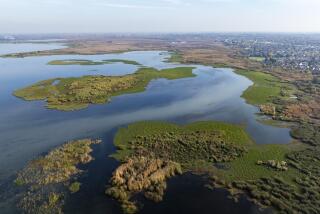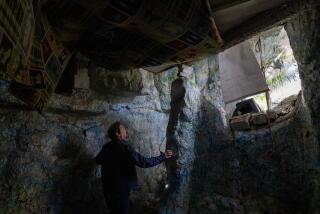Common ground over a besieged wetlands
Lennie Arkinstall deftly steered his 14-foot aluminum skiff through murky tidal inlets teeming with shorebirds and strewn with trash in the heart of the degraded salt marsh known as the Los Cerritos Wetlands.
The groundskeeper of the privately owned mosaic of mud flats and oil fields framed by power plants, tank farms, malls and busy highways a few miles east of downtown Long Beach wanted to show off the area’s potential as a wildlife refuge.
Ahead of him, a solitary common loon bobbed in shallows edged by spongy carpets of pickleweed stretching out to a mobile home park. Kingbirds preened on tangled heaps of rusted scaffolding. The flotsam and jetsam of the surrounding urban watershed littered shoals pocked with the burrows of ghost shrimp and horned snails: fast-food wrappers, beer cans, cigarette butts.
“This place has incredible potential,” Arkinstall said over the putt-putt of his small outboard engine. “Just add a little water and cleanup work and, boom! You’ve got instant thriving ecosystem.”
After fighting for decades over its oil and land, conservationists, developers and city planners are joining forces to let the wetlands grow wild again. Earlier this month, the city of Long Beach announced a proposed land swap with a developer that would protect the 175-acre core of the wetlands in exchange for 52 acres of city-owned property. The city would then sell the marsh to the Los Cerritos Wetlands Authority for about $25 million.
It won’t be easy sealing the deal. The issues surrounding the wetlands’ future are complex. But at the heart of the ongoing debate is a hope that the wetlands can bounce back and become a model of restoration and cooperation.
Just in time, some might say.
The wetlands on the Long Beach-Seal Beach border at the mouth of the San Gabriel River once stretched 2,400 acres. Today, little more than 400 acres remain, including the 175-acre parcel owned by developer Thomas Dean.
The developer’s willingness to consider a land swap rather than an outright sale of the wetlands -- bordered by Pacific Coast Highway, Studebaker Road and the Los Cerritos Channel -- was key to bringing the warring parties together.
In return, Dean would get a bundle of underutilized city property, including a 29-acre parcel known as Sports Park -- a weedy crop of hills studded with oil pumps and abandoned corrugated metal structures -- and a 12-acre public service yard housing welding, paint and locksmith shops, and stacks of streetlight stanchions.
If all goes according to plan, commercial and light industrial development on those parcels will generate jobs and taxes, and Dean will keep the mineral rights on the wetlands, allowing him to continue pumping an estimated $3 million worth of oil a year.
“Long Beach will have an oasis in an urban environment,” Assistant City Manager Suzanne Frick said. “The ability to open it up for everyone to enjoy is amazing.”
The Long Beach City Council has begun workshops with neighborhood associations, conservation groups and others to map a strategy for completing the swap and launching a restoration program.
The issues are daunting. Many low-income residents on the industrialized west side of Long Beach are fuming over the proposal, which they believe would mostly benefit the city’s wealthier eastern half. Of particular concern is the city’s offer to trade Sports Park, which has long been considered a potential home for soccer, football and baseball fields in an area in need of recreational opportunities.
Long Beach officials have said the financially strapped city lacks the estimated $50 million needed to develop the sports park site, which has become a critical component of the land swap. But City Councilwoman Tonia Reyes Uranga, whose 7th District includes much of the west side, said the proposal underscores what she called an ongoing “tale of the haves and the have-nots in Long Beach.”
“Residents in east Long Beach enjoy 16 acres of parkland per 1,000 residents,” she said, “while west Long Beach residents are left with one acre of parkland per 1,000 residents.”
Reyes Uranga, backed by west-side community organizations and organized sports groups, has vowed to oppose the swap unless the city first “frees up more space for our neighborhood youth.”
Mike Conroy, the city’s director of public works and an architect of the swap proposal, said he has identified several parcels that could become additional park space for west-side residents.
In the meantime, Arkinstall and Cal State Long Beach biologist Eric Zahn have been outlining options for reviving the estuary, a formidable task that would call for hauling out tons of rubbish, uprooting dense hedges of non-native pampas grass and thistle, and taking down dozens of Mexican fan palms. It might also include diverting runoff from local streets to form freshwater sanctuaries for migrating birds while replenishing the land.
Over the last decade, Arkinstall has spent so much time collecting trash in the area that “the shorebirds think I’m one of them now.”
“Two years ago, I hauled out 70 tons,” he said.
During a recent tour of the wetlands, Arkinstall and Zahn suggested that the toughness of the place has helped preserve it. That resilience is reflected in the tenacity of rare plants -- estuary seablite and Southern tarplant, for example -- that cling to briny flats in the shadow of working oil rigs; in the three families of coyotes that recently had pups in secluded burrows; and in wandering skipper butterflies that lay their eggs only in salt grass.
Arkinstall believes his trash removal has contributed to a dramatic increase in the number of endangered Belding’s savannah sparrows, a dun-colored bird that nests in tidelands.
“Belding’s savannah sparrows are thick here,” he said. “We’ve got at least 33 pairs. Twenty years ago there were two pairs.”
There is also a tide in the wetlands that commands a cycle of growth and replenishment in inlets that provide havens for shellfish and marine plants and are patrolled by halibut, smoothhound sharks and schools of smelt.
Said Zahn, peering through binoculars: “Watching endangered California least terns, a graceful gull-like bird, teach their young to fly and catch fish in those inlets is a beautiful thing to see.”
Sahagun is a Times staff writer.
More to Read
Start your day right
Sign up for Essential California for news, features and recommendations from the L.A. Times and beyond in your inbox six days a week.
You may occasionally receive promotional content from the Los Angeles Times.







